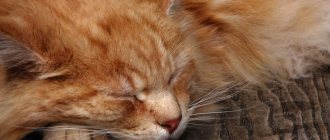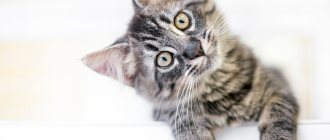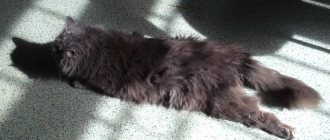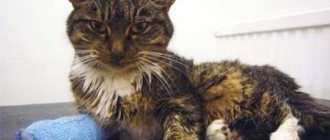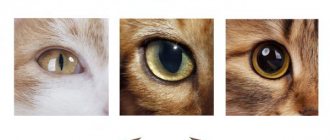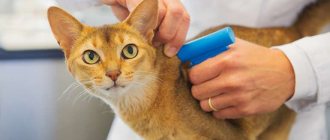Prevalence and modes of infection Pathogenesis and symptoms Diagnostics Treatment Home animal care Prevention Prognosis Feline viral immunodeficiency
(FIV or FIV) is a predominantly silent infection that is characterized by damage to the immune system. It is caused by a retrovirus, its structure and biochemistry is similar to the human AIDS virus.
Clinical signs of FIV are similar to those of HIV, but FIV cannot infect primates, incl. person. The FIV virus was first discovered in 1986 in Northern California.
Prevalence and methods of infection
Most often, the virus occurs in adult and old cats (over 5 years old) that roam freely on the street. Moreover, cats get sick more often than females. Animals protecting their territory are especially prone to infection. The virus occurs in 1-3% of clinically healthy animals and in 9-15% of cats with clinical signs of a disorder in the immune system. The virus is found in the blood, saliva, urine and other body fluids of the animal. The main route of transmission is parenteral (through bites), less often the virus is transmitted transplacentally, during childbirth and with milk from mother cats to kittens.
The saliva of infected cats contains the maximum amount of virus.
The virus is unstable in the external environment and is destroyed under the influence of solar radiation and drying, so its spread in a group of animals occurs only through direct and close contact.
Preventive measures
There is no special preventive vaccination against feline AIDS yet, but there are vaccines that have a wide spectrum of action. For example, in 2002, American scientists created the Felovax vaccine (Fel-O-Vax FIV, Fort Dodge Animal Health). This vaccination can only be given to healthy cats and kittens over 8 weeks of age. Studies have shown that up to 80% of cats were protected from AIDS with the help of this drug. However, there is a caveat here: such an injection can cause soft tissue sarcoma at the injection site, so only those cats that are most susceptible to infection are vaccinated.
Vaccines can protect your cat from AIDS
In Russia, few people vaccinate their pets with such drugs. Most preventive measures are aimed at limiting the possibility of infection:
- excluding the possibility of the cat freely walking and communicating with street animals;
- castration of cats (allows to reduce the number of fights between them);
- castration/sterilization of infected cats (excludes infection of kittens, including intrauterine);
- isolation of cats with immunodeficiency from healthy animals;
- testing all newly acquired cats for the presence of the virus;
- mating only with proven males;
- If a cat is planned to be included in a breeding program, then it needs to be tested and vaccinated.
Feline immunodeficiency and HIV infection in humans are similar diseases, but FIV is not dangerous for humans. Infected cats can live long and happy lives, even though feline AIDS is incurable. However, to maintain the normal life of a virus-carrying cat, lifelong treatment may be required.
Pathogenesis and symptoms of FIV in cats
The development of the disease occurs in several stages.
The acute phase begins 3-4 weeks after infection. The virus quickly replicates (multiplies) in lymphoid tissue (lymphocytes and macrophages). Fever, weakness, and lymphadenopathy may occur, but some cats may have no clinical signs.
Then, in most cats, the clinical manifestation of the disease subsides and the animals look healthy. During the latent (hidden) phase, the amount of circulating virus decreases. Ultimately, the virus suppresses the function of B and T lymphocytes, and a decrease in cellular and humoral immunity occurs. This is expressed in a decrease in the number of lymphocytes, neutrophils and an increase in globulins in the animal’s blood. Clinically, this can manifest itself in different ways. In addition, the virus can provoke changes not related to immunity (neuropathy, damage to the respiratory tract and gastrointestinal tract).
Due to decreased immunity, secondary bacterial, viral and fungal diseases and neoplasms (lymphosarcoma, etc.) develop in the body. Chronic bacterial and fungal microflora are activated. Severe infections that accompany immunodeficiency in cats include calicivirus, chlamydia and Microsporum canis.
Presumably, the immunodeficiency of cats itself does not lead to the death of the animal, but only aggravates the course of the underlying disease. Viral immunodeficiency can occur without secondary infections. Clinical signs of FIV may be similar to those of feline leukemia virus.
Due to the fact that the very first signs of the disease are nonspecific and are often mistaken for a slight malaise, clinical signs of the active phase of FIV should be highlighted:
- neurological signs (motor and sensory disorders, sleep disturbances, aggressiveness or apathy);
- indolent skin diseases in cats;
- increased body temperature;
- lymphadenopathy;
- exhaustion;
- anemia;
- diseases of the oral cavity (stomatitis, gingivitis). They begin at a young age and appear throughout the life of the animal until the active phase of the disease;
- chronic respiratory diseases (laryngitis, bronchitis, rhinitis);
- eye diseases (uveitis, glaucoma).
It should be mentioned that with feline viral immunodeficiency in animals older than 7-8 years, the risk of developing lymphosarcoma and, presumably, squamous cell carcinoma increases. Other types of neoplasms are not associated with feline immunodeficiency, but, nevertheless, when they appear, cats should be examined for FIV, because the choice of treatment depends on this.
How to treat immunodeficiency virus in adult animals
Cats suffering from FIV infection are treated symptomatically, and it is not yet possible to get rid of the virus itself.
Viral immunodeficiency, unfortunately, cannot be cured, but it is possible to maintain a decent life for an animal.
Svetlana Vladimirovna Spiridonova, veterinarian
https://www.zoovet.ru/forum/?tid=7&tem=985123
Many owners of sick cats, after consulting with a veterinarian, decide to support their pets with antiviral drugs. However, not all experts believe that this helps the animal. The fact is that if you start giving your cat medications to boost immunity and then abruptly stop using them, the animal’s body will malfunction. The virus will increase its negative impact on the body, and the cat will become worse. Therefore, if you decide to support your pet with such drugs, then know that this is forever. The following drugs are usually prescribed as such drugs:
- Anti-influenza immunoglobulin (or anti-measles);
- Zidovudine (in parallel with the use of the medicine, you need to monitor your blood condition - take tests every week);
- Virbagen Omega (Feline interferon-w) is a recombinant interferon for cats.
Photo gallery: antiviral drugs to support the cat’s body
Virbagen Omega was developed specifically for animals, so it does not cause any side effects, but some veterinarians consider this drug to be ineffective
Zidovudine (Retrovir) is developed for humans, so it may cause side effects (vomiting, anemia, etc.) in cats.
Medicines that were created to treat people with HIV infection can be expensive (depending on the manufacturer)
In addition to antiviral drugs, immunomodulators and immunostimulants may be prescribed. Their effectiveness in FIV has not been proven, but there is no data on the harm of these drugs. Medicines that support the affected immune system of a cat can fight some secondary infections. Typically, animals are prescribed one of the following immunostimulants:
- Glycopene (available in tablet form, dosage depends on the weight of the animal);
- Anandin (cannot be used to treat cats with renal failure);
- Fosprenil;
- Roncoleukin;
- Ribotan;
- Polyferrin-A;
- LTCI (T-lymphocyte immunostimulator) is considered one of the most effective drugs for FIV.
Photo gallery: immunomodulators and immunostimulants for FIV
Anandin should be used with extreme caution (many side effects)
Polyferrin is a protein preparation of lactoferrin, not sold in every veterinary pharmacy.
Immunodeficiency is the main indicator for taking Ribotan, but the drug can cause an allergic reaction
Fosprenil is one of the most popular immunomodulators for maintaining the immunity of cats.
Roncoleukin is based on a yeast strain, so the active substance can cause allergies
Glycopene must be used regularly; even one missed dose of the medication can lead to “zeroing” the effectiveness
To suppress pathogenic microflora, the veterinarian may prescribe antibiotics:
- ampicillin;
- Ampiox;
- cephalosparin;
- penicillin, etc.
To make the antibiotic more effective, it is sometimes combined with corticosteroids. But there is a caveat: when choosing such drugs, the veterinarian must ensure that the recommended drug does not reduce immunity. In addition, a cat with immunodeficiency may be prescribed antihistamines:
- Diphenhydramine;
- Suprastin;
- Pipolfen;
- Loratadine;
- Tavegil, etc.
Photo gallery: antihistamines for immunodeficiency
Antihistamines can relieve itching, swelling and allergic reactions
Many antihistamines have a sedative and hypnotic effect
Sedatives can relax smooth muscles and relieve pain
Some antihistamines have an antiemetic effect
The immunodeficiency virus suppresses the activity of the bone marrow, which can cause hematological disorders (neutropenia, lymphopenia, anemia, etc.).
When children ask me what anemia is, I explain, as they say, on my fingers. Blood consists of cells of different colors. When there are few red erythrocytes in the blood, anemia (anemia) develops. And when there are not enough white blood cells in the blood - lymphocytes - this is called lymphopenia. With this disease, the body loses its main immune soldiers, because lymphocytes are needed to fight infections. Neutropenia is one of the conditions associated with lymphopenia.
To combat these conditions, the following drugs are prescribed:
- Neupogen, Leucostim, Filgrastim, etc. (for neutropenia);
- Epocrine, Epoetin Beta, Erythrostim, etc. (for anemia).
Photo gallery: drugs prescribed for hematological disorders
The international name of Neupogen and Leucostim is Filgrastim
Recormon and similar products are well tolerated by cats, so they can be used for a long time
An analogue of Epoetin Beta is the drug Epocrin
To correct hematological conditions, you can choose a domestic or imported drug, the difference will only be in the cost of the drug
Blood transfusions are sometimes indicated in the treatment of anemia. This procedure gives a good result, so you can quickly and effectively achieve an increase in red and white blood cells. However, transfusion is not available in every clinic, and this procedure only gives a temporary effect. Foreign blood cells can cause anaphylaxis (a rare type of intolerance) - this phenomenon can kill the cat.
Usually all treatment comes down to taking vitamins and fighting secondary infections. The fact is that antiviral drugs and bone marrow stimulants are not cheap. For example, the price for 1 ampoule of Neupogen can reach 5 thousand rubles, and a package of Erythropoietin can reach 4 thousand rubles. Some drugs are not sold in Russia at all, so loving and desperate cat breeders order imported drugs, which are even more expensive. In addition, veterinarians rarely prescribe such effective remedies, since feline AIDS is not always diagnosed.
But not everything is as sad as it seems. Compared to people who have HIV infection, cats with FIV can survive. Cases of animal deaths from AIDS are rare. The life of domestic animals is much shorter than that of a human, so infected cats do not have time to feel the full impact of the insidious virus. Even if the diagnosis is made at the age of 10 years, and the owner supports his pet with medications and care, the animal can live for another 5–8 years. And the average life expectancy of cats is 15–16 years. Therefore, there is no need to despair and resort to extreme measures. On the contrary, give your pet more attention and care, and he will thank you with a happy purr.
Do kittens get sick and how to treat them?
Kittens can also get AIDS, but this is rare. Since, most likely, the infection occurred from the mother cat, you can initiate an examination of the baby. If your cat feels unwell, and you suspect she has FIV infection, then she and all the kittens should be taken to the veterinarian.
Kitten owners are worried that their little pets may be infected at an early age
Treatment for kittens is the same as for adult animals. The only difference will be in the dosage of the drugs. Firstly, this is due to the fact that in babies the immune system is not fully formed. If from an early age a cat lives entirely on artificially acquired antibodies, then in the future the animal’s body will not be able to independently resist even mild infections. And secondly, many drugs prescribed for FIV are created for treating people, and this is a completely different concentration of active substances.
In the case of immunodeficiency in kittens, everything depends on the veterinarian. The specialist must not only recognize the infection, but also prescribe competent support for the baby’s body. It may also be that FIV infection in a kitten is in a latent state. In this case, you don’t have to stuff the animal with strong drugs. This will require proper care, because the owner will have to protect his pet from viruses and infections. Some cat breeders, when a virus is detected in kittens, think about euthanizing them, but I believe that this is inhumane.
Diagnostics
To make a final diagnosis, the veterinarian collects venous blood and sends it to the laboratory.
The main method of laboratory diagnosis is the determination of antibodies in the animal’s blood serum to the feline immunodeficiency virus. Enzyme-linked immunosorbent assay (ELISA), immunofluorescence, PCR, etc. are used.
Laboratory testing should not be carried out earlier than 12 weeks after the suspected infection (bite), because There may be no antibodies to FIV in the blood. Up to 10% of cats may not have the required antibody titer to be detected. Many cats may not produce an immune response until they are 12 to 14 months old, at which time they develop antibodies. In addition, at 7-8 weeks from the moment of infection, the level of antibodies in cats may drop significantly and become undetectable. This is due to the strong suppression of the immune system during this period.
In the acute phase of the disease, some nonspecific signs of immunodeficiency can be identified: in the blood there is a decrease in the level of leukocytes, lymphocytes, neutrophils, anemia, an increase in gamma globulin; as well as follicular dysplasia and lymph node degeneration.
In cases where FIV is suspected, serodiagnosis gives negative results, the virus can be detected by PCR.
Risk factors
The immune system of a healthy cat limits the development of the virus, so the whisker looks healthy outwardly. When immunity weakens, the disease progresses. Factors contributing to the development of FIV in a cat will be:
— chronic diseases;
— low-quality feed and unbalanced diet;
— infectious diseases (especially herpes virus);
Read more: Treatment of herpes in cats
- stress;
- internal and external parasites.
Treatment of feline viral immunodeficiency
Therapy for feline viral immunodeficiency, like HIV therapy, includes symptomatic treatment (acts on clinical signs of the disease), suppression of the activity of secondary microflora and treatment and reduction of the risk of concomitant diseases. In this case, antibiotics, corticosteroids, and, if necessary, special diets and immunomodulators are used.
In some cases, with FIV it is possible to use specific antiviral drugs that are used in human medicine in the treatment of AIDS. But they are quite toxic and, if discontinued, contribute to a greater spread of the virus and the development of a severe clinical situation.
Epizootic
How can you get infected, is it dangerous for humans? The statistical peak of infection occurs in pets over the age of five. At the same time, the incidence of the disease in males is observed twice as often as the incidence of the disease in cats. As a rule, the disease enters a chronic phase. Cats living indoors and not associated with stray animals are generally not at risk. Wild and street cats get sick much more often than others. Serological analysis reveals the presence of antibodies in 30% of cats that are in contact with a sick animal.
The source of infection is sick individuals. Transmission of infection occurs through saliva, milk or exudate, which contain cells infected with viruses. Among the items that most often serve as carriers of infection, feeders and drinking bowls come first. In second place on the list of dangers are bites during the game. The infection spreads through the air only if the oral mucosa is damaged.
In microbiological studies, the maximum concentration of virions was observed in salivary fluid. Therefore, today the main source of danger is considered to be mutual bites during the period of clarification of relations between cats. Infection through bites has received experimental confirmation. Infection of the embryo through the placenta also occurs, as well as transmission of infection from a sick mother to the cubs through mother's milk during breastfeeding. Sexual transmission of the disease has not yet been identified. The transmission of infection from cats to animals of another species or to people has never been observed.
Outbreaks of the disease are observed regardless of the time of year and are repeated several times in a certain area.
Forecast
The prognosis for feline viral immunodeficiency is cautious. In 20% of cases, animals die within 2 years from the moment of diagnosis (4-6 months from the moment of infection), but more than 50% of infected animals remain clinically healthy at this time. At the last stage of the disease (exhaustion, frequent and severe infections), the average life expectancy is about one year.
(c) Veterinary center for the treatment and rehabilitation of animals “Zoostatus”. Varshavskoe highway, 125 building 1. tel.
8 (499) 372-27-37
Prevention
At the moment, FIV is a poorly studied infection, so a preventive vaccine against this infection has not been developed in our country or abroad. It is very important to prevent your pet from contracting a dangerous infection. Monitor the cat’s condition and behavior, strengthen the immune system, and consider the correct diet. If the cat is kept on a natural diet, give fortified food supplements and complex vitamins to strengthen the immune system.
If a cat is walking on the street, we recommend spaying or sterilizing the animal. This will avoid uncontrolled mating and fights between individuals of the same sex. Uncoated males behave more aggressively and are intolerant of their relatives.
Do not neglect vaccinations and deworming. Systematically treat your pet with products against external parasites, regardless of whether the cat walks outside or does not leave the house. If you notice signs of illness, do not delay your visit to the veterinary clinic. Many diseases can be cured only in the early stages of development.
Caring for a sick animal
The purpose of such care is to prevent secondary infections, which are very dangerous for an immunodeficient animal. Therefore, it is important to choose the right food for your pet, preferably dry, since it is less conducive to the deposition of tartar - the source of many infections. At the same time, it is recommended to give vitamin complexes.
None Knowing information about feline AIDS, such as what it is and how it develops, is important to protect your pet from parasites. After all, their bites can transmit various dangerous diseases.
[custom_ads_shortcode3]
Main symptoms
Symptoms of immunodeficiency in cats do not appear immediately. In 18% of those infected, the disease is asymptomatic, reminding of its existence only after the development of secondary diseases.
The first alarming symptoms can be detected after the end of the incubation period. These include:
- inflammation of the lymph nodes;
- loss of activity and appetite;
- hyperthermia (temperature rises above 40 °C);
- weight loss;
- diarrhea and severe dehydration.
With subsequent infection with other infections, the symptoms expand. At this point, the patient’s condition attracts the owner’s attention, as the clinical picture becomes more specific.
Stage of penetration into the body
After entering the blood, the virus is introduced (replicated) into cells sensitive to it - white blood cells. At this stage, the disease does not manifest itself clearly:
- slight increase in temperature;
- inflammation of the lymph nodes;
- increased fatigue.
[custom_ads_shortcode2]
Carrying out immunotherapy
After a complete diagnosis has been completed and the type of immunodeficiency has been determined, the immunologist selects an individual treatment regimen.
The use of immunotherapy (drugs for the correction of immunity) is aimed at strengthening the functioning of the immune system, correcting the imbalance of immune reactions, suppressing the aggression of autoimmunity, and pathologically active processes. It is also important to stimulate the parts of immunity that are impaired in a particular patient.
Prof. Ignatiev V. A.
Sources:
- M. Yesenaliev. Acquired immunodeficiency syndrome is the main problem of public health // Bulletin of AGIUV, 2013, No. 1, pp. 64-65.
- Yu.N. Fedorov, V.I. Klyukina, M.N. Romanenko, O.A. Bogomolova, A.N. Denisenko. Strategy and principles of immunocorrection and immunomodeling therapy.
- Raje N, Dinakar C. Overview of Immunodeficiency Disorders // Immunol Allergy Clin North Am. 2015 Nov;35(4):599-623. doi: 10.1016/j.iac.2015.07.001. Epub 2015 Aug 25.
Forecasts for the future
The prognosis directly depends on the condition of the animal and the course of the disease. If diagnosed at a late stage, a cat can live for about a year. At this point, the body is severely depleted by chronic diseases and is maximally vulnerable to any infections.
Death from FIV is rare. On average, cats with this diagnosis live 5-8 years. Given the average life expectancy, FIV-infected pets are more likely to die from old age rather than from infection.
To ensure a long and happy life for a mustachioed pet, the owner will have to regularly give it all the necessary medications and protect it from other diseases with the help of:
- Castration and sterilization. After the operation, the animals become calmer and less likely to get into fights with their relatives.
- Isolation from other animals. Due to a weakened immune system, another infection on the street can be fatal. This will also prevent further spread of FIV.
- Timely treatment for fleas, ticks and worms.
- Avoiding stress. During exciting events (moving, birth of a child, renovation), use calming medications with pheromones.
- Annual vaccination. Vaccinations are permissible only in latent cases and only in a “killed” form. A vaccine administered during an acute form can lead to severe complications.
- Therapeutic diet. Veterinarians recommend using dry food. They prevent the formation of tartar, which is the cause of many diseases.
- Annual blood donation. Regularly checking the results will help to identify possible deviations in a timely manner and adjust the treatment plan.
Before contacting a sick pet, be sure to wash your hands and do not forget to put away your outdoor shoes immediately after returning home. Check the condition of your cat's skin, fur, and mouth daily. The cat must be weighed once a week to guard against sudden weight loss.
